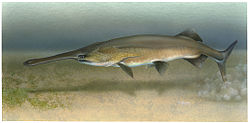Paddlefish
| Paddlefishes Temporal range: Early Cretaceous–Recent |
|
|---|---|
 |
|
| American paddlefish | |
 |
|
| Chinese paddlefish | |
| Scientific classification | |
| Kingdom: | Animalia |
| Phylum: | Chordata |
| Class: | Actinopterygii |
| Order: | Acipenseriformes |
| Family: |
Polyodontidae Bonaparte, 1838 |
| Genera | |
Paddlefish (family Polyodontidae) are basal Chondrostean ray-finned fish. They have been referred to as "primitive fish" because they have evolved with few morphological changes since the earliest fossil records of the Late Cretaceous, seventy to seventy-five million years ago.Polyodontids are exclusively North American and Chinese.
There are six known species: four extinct species known only from fossil remains (three from western North America, one from China), and two extant species, including the American paddlefish (Polyodon spathula) which is native to the Mississippi River basin in the U.S. and the critically endangered Chinese paddlefish (Psephurus glades) which is endemic to the Yangtze River Basin in China. Chinese paddlefish are also commonly referred to as "Chinese swordfish", or "elephant fish".
Paddlefish populations have declined dramatically throughout their historic range as a result of overfishing, pollution, and the encroachment of human development, including the construction of dams that have blocked their seasonal upward migration to ancestral spawning grounds. Other detrimental effects include alterations of rivers which have changed natural flows resulting in the loss of spawning habitat and nursery areas. Chinese paddlefish have not been seen since 2007, and may now be extinct for many of the same reasons that have plagued the American species.
During the initial stages of development from embryo to fry, paddlefish have no rostrum (snout). It begins to form shortly after hatching. The rostrum of a Chinese paddlefish is narrow and sword-like while the rostrum of the American paddlefish is broad and paddle-like. Some common morphological characteristics of paddlefish include a spindle-shaped, smooth skinned scaleless body, heterocercal tail, and small poorly developed eyes. Unlike the filter-feeding American paddlefish, Chinese paddlefish are piscivores, and highly predaceous. Their jaws are more forward pointing which suggest they forage primarily on small fishes in the water column, and occasionally on shrimp, benthic fishes, and crabs. The jaws of the American paddlefish are distinctly adapted for filter feeding only. They are ram suspension filter feeders with a diet that consists primarily of zooplankton, and occasionally small insects, insect larvae, and small fish.
...
Wikipedia
